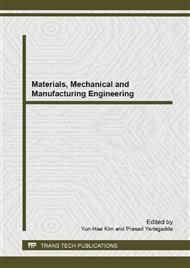p.427
p.433
p.439
p.445
p.449
p.455
p.462
p.466
p.470
Numerical Simulation of Free Surface Flows by Using Weakly Compressible Corrected MPS Method
Abstract:
Mesh-free particle (Lagrangian) methods such as Moving Particle Semi-Implicit (MPS) are the latest generation of methods in the field of computational fluid dynamics where large interfacial deformations and fragmentations exist. Due to their mesh-free nature, these methods are capable of simulating any kind of boundary/interface deformation and fragmentations. In this study the weakly compressible corrected MPS (WCC-MPS) method is used to simulate dam break over a dry bed, which is a highly erosive and transient flow problem. The developed numerical model is first validated using a dry bed dam break problem by comparing with experimental data. Comparisons between the model results and experimental data showed that the developed numerical model with WCC-MPS method can well represent the dam break problems with very large free surface deformation and fragmentations.
Info:
Periodical:
Pages:
449-454
Citation:
Online since:
November 2013
Authors:
Price:
Сopyright:
© 2014 Trans Tech Publications Ltd. All Rights Reserved
Share:
Citation:


